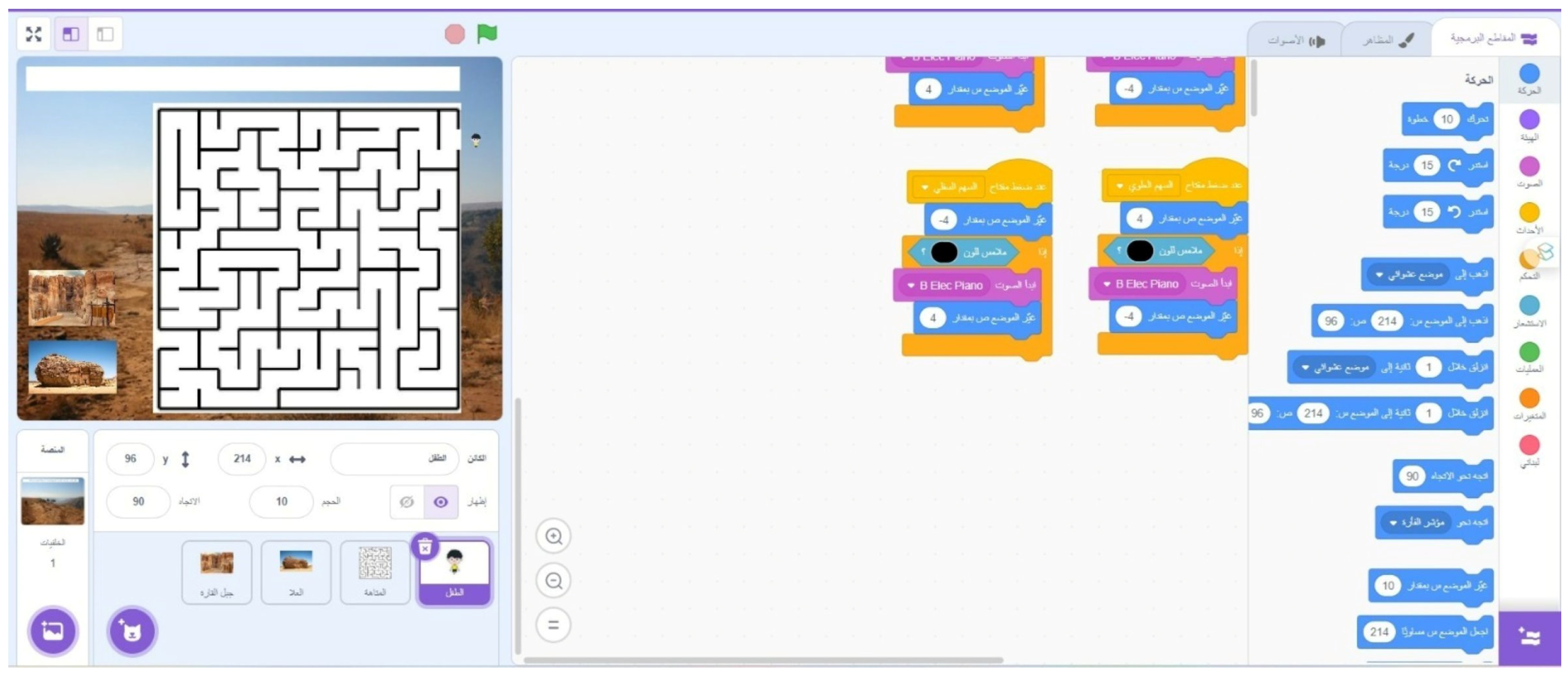Teacher Education: Design Thinking Approach in Makerspaces to Produce Quality Educational Video Games with a Visual Identity and Improve Design Thinking Skills
Abstract
:1. Introduction
2. Literature Review
2.1. Educational Video Games with a Visual Identity
- Environmental Design in Games: The environments and virtual backgrounds of the game should be designed in a way that complements the educational content and creates an immersive learning experience. Mohamad Yahaya et al. [48] found that environmental design in online games has a significant impact. Studies have shown that virtual forest games can enhance positive mood and mental health. Mostajeran et al. [49] further explained that environmental design in virtual games can induce positive emotional and physiological effects. They conducted a study with 27 participants to examine the psychological effects of such exposure. The results showed that exposure to virtual nature significantly improved cognitive performance and restoration ability.
- Graphic Design and User Interface in Games: The visual design of the game should reflect the educational theme and enhance player engagement, creating a cohesive visual identity for the game. By using consistent and visually appealing graphic design, Sentana et al. [50] discussed the impact of graphic design in online games and emphasized the importance of attractive visual elements and principles of animation in creating a high-quality game that influences player behavior.
- The Use of Visual Elements in Games: Relevant symbols or visual elements that represent educational concepts or actions should be integrated within the game. Visual aesthetics, including colors and patterns, play a crucial role in shaping the user experience and engagement in online games.
- Characters and Avatars in Games: Developing unique and visually appealing characters or avatars that align with the educational content can enhance the visual identity of the game. These characters can represent teachers, mentors, or even the players themselves. Designing characters that reflect diversity and inclusivity can create a welcoming and relevant experience for players. Allowing players to customize specific visual aspects, such as their character’s appearance or the game interface, can enhance engagement and create a sense of ownership [51]. It allows players to personalize the appearance and elements of their avatars, leading to a sense of identification with the character and enhancing player loyalty to the game [52].
2.2. Design Thinking Approach in the Makerspace
- Empathize: This stage involves understanding the core idea and empathizing with it. It entails researching user needs, consulting experts to learn more about the domain of interest, making observations, and gaining an empathetic understanding of the problem that the product design aims to contribute to solving.
- Define: In this stage, the problem to be solved is identified by organizing the information and refining the details gathered from the empathize stage. The focus is on the problem, and great ideas are generated with a human-centered approach.
- Ideate: This stage involves generating creative solutions to the problem. Various ideation techniques such as brainstorming, mind mapping, and asking questions can be used to stimulate free thinking and explore a wide range of solutions and ideas. This allows for the generation of the highest possible number of ideas.
- Prototype: This stage involves creating and testing solutions and iterating on them. The implementation begins by producing a number of product versions to make the ideas tangible. These prototypes can be shared and tested within the team itself, in other departments, or with a small group of individuals outside the team. They are investigated, and based on user feedback, they are accepted, improved, or rejected. By the end of this stage, a clearer vision is formed of how real users behave, think, and feel when interacting with the final product.
- Test: The prototypes produced in the prototype stage are tested by conducting interviews with users and presenting the product to them. Their interactions and reactions are observed in order to gain a deep understanding of the product and real users as much as possible. This helps improve the final product and put it in its finalized form.
- Select one or two skills related to students’ learning needs to focus on.
- Engage students in discussions or brainstorming sessions where they can share their interests and experiences.
- Divide the work purposefully.
- Start exploring real problems that impact their lives within their community, personal, local, or global events.
- Document learning evidence such as assessment models and review lists.
- Encourage students to express the problem in different ways, such as writing it down or creating a teaching scenario, to make their growth visible to themselves and their teacher.
- Prompt students to think collaboratively to arrive at creative solutions.
- Use self-assessments to help students identify their strengths.
2.3. Product Quality
3. Research Questions
4. Hypotheses
5. Participants
6. Methodology
7. Data Collection and Analysis
7.1. Product Quality Card
7.2. Design Thinking Scale
8. Experimental Procedure
- Digital tools: computers, smartphones, printers, scanners, internet connection, sound effects software, audio recordings, microphone for sound recording, drawing software, audio recording software, game programming software, QR codes, PowerPoint, YouTube video clips, Scratch website and mobile phone application for designing educational video games, projectors, graphic design tools, and space for storing items.
- Manual tools: ruler, pens, eraser, compass, colored pencils, blocks, whiteboards for collaboration, concept maps, tools for drawing and planning background and character designs, programming blocks, paper for scenario drawing, and whiteboard.
- Empathize: In this stage. the basic idea is understood and empathized with. In the makerspace, pre-service teachers from the Department of Educational Technology and the Department of Art Education started by conducting interviews with their fellow pre-service kindergarten teachers. They used a questioning strategy to encourage students to develop their perspectives in order to understand their interests, inquire about their needs, and identify the main topics that need to be designed as educational video games that align with the educational objectives for this age group, as well as with the customs, values, history, and culture of the community. The empathize stage in the makerspace includes using a set of tools such as PowerPoint, YouTube, clipboard, pens, papers, interview guides, and illustrative presentations; sharing video clips and images; presenting ideas that empathize with the problem; and using PowerPoint or videos to demonstrate the idea.
- Define: In this stage, the problem to be solved is identified. The students move to the designated area in the makerspace for the “Define” stage. Pre-service teachers facilitate brainstorming sessions to exchange ideas about a societal problem that aligns with the first objective of the skills of designing an educational video game with visual identity, which is “the overall game concept planning”. One educational objective is selected for each game that suits kindergarten children, and the gameplay is defined. The space is equipped for discussion and idea generation, including tools such as PowerPoint, YouTube, sticky notes, highlighter pens, and whiteboards. The discussions resulted in generating ideas such as the need for games that address specific topics related to the community and its culture, such as learning about currencies, the colors of the flag, and so on.
- Ideate: This stage involves generating creative solutions to the problem. The students move to the designated area in the makerspace for the “Ideate” stage. Pre-service teachers present their initial prototypes of solutions, aligning with the second and third objectives of the skills of designing an educational video game with visual identity, which are “designing the educational game scenario” and “designing visual elements”. The space is equipped with tools such as PowerPoint, YouTube, papers, pens, and colors for writing the game scenario. Additionally, digital tools such as computers and Scratch software are available for designing characters, their outfits, sound effects, and audio. This stage resulted in presenting the game scenario; designing character and outfit prototypes, backgrounds, control buttons; and incorporating colors that align with the community.
- Prototype: This is the stage of testing and improving solutions. The students moved to the makerspace designated for the “Prototype stage”, which included the fourth objective of the skills of designing an educational video game with a visual identity, which is “programming the game using the Scratch program” (Figure 5). where they create prototypes for designing the game by adding game programming codes, such as sound, control, and movement codes, as well as review the game and modify its elements. The place was equipped with tools for testing and improving solutions, such as plastic cubes to help in learning programming, PowerPoint, YouTube, PDF, electronics tools, computers, and projects, etc. It resulted in the projects being presented and the students testing their prototypes with pre-service kindergarten teachers and making improvements based on their feedback.Figure 5. Prototyping a video game to discover Al-Ula’s historical monuments.
- Testing: Testing involved initial interactions with pre-service kindergarten teachers, discussing all the comments and analytical analyses, monitoring their interaction with the games, and seeking their opinions.
9. Data Analysis and Results
10. Discussion
11. Conclusions
Author Contributions
Funding
Institutional Review Board Statement
Informed Consent Statement
Data Availability Statement
Conflicts of Interest
References
- Brunt, C.S.; King, A.S.; King, J.T. The influence of user-generated content on video game demand. J. Cult. Econ. 2020, 44, 35–56. [Google Scholar] [CrossRef]
- Şener, D.; Yalçın, T.; Gulseven, O. The Impact of COVID-19 on the Video Game Industry. 2021. Available online: https://ssrn.com/abstract=3766147 (accessed on 30 October 2023).
- Moore, M. Basics of Game Design; CRC Press: New York, NY, USA, 2016. [Google Scholar] [CrossRef]
- Keo, M. Graphical Style in Video Games. Bachelor’s Thesis, HAMK Häme University of Applied Sciences, Hämeenlinna, Finland, 2017. Available online: https://core.ac.uk/download/pdf/93082889.pdf (accessed on 14 February 2023).
- Shannon, T. Unreal Engine 4 for Design Visualization: Developing Stunning Interactive Visualizations, Animations, and Renderings; Addison-Wesley Professional: Boston, MA, USA, 2017. [Google Scholar]
- Vorderer, P.; Bryant, J.; Pieper, K.M.; Weber, R. Playing Video Games as Entertainment. In Playing Video Games: Motives, Responses, and Consequences; Vorderer, P., Bryant, J., Eds.; Lawrence Erlbaum Associates Publishers: New York, NY, USA, 2006; pp. 1–7. [Google Scholar]
- Mortara, M.; Catalano, C.E.; Bellotti, F.; Fiucci, G.; Houry-Panchetti, M.; Petridis, P. Learning cultural heritage by serious games. J. Cult. Herit. 2014, 15, 318–325. [Google Scholar] [CrossRef]
- Garneli, V.; Chorianopoulos, K. Programming video games and simulations in science education: Exploring computational thinking through code analysis. Interact. Learn. Environ. 2018, 26, 386–401. [Google Scholar] [CrossRef]
- Hébert, C.; Jenson, J.; Terzopoulos, T. “Access to technology is the major challenge”: Teacher perspectives on barriers to DGBL in K-12 classrooms. E-Learn. Digit. Media 2021, 18, 307–324. [Google Scholar] [CrossRef]
- Wolf, M.J.P. Video games as American popular culture. Quad. Cine. 2017, 12, 119–128. [Google Scholar] [CrossRef]
- Keogh, B. The cultural field of video game production in Australia. Games Cult. 2021, 16, 116–135. [Google Scholar] [CrossRef]
- Muriel, D.; Crawford, G. Video Games as Culture: Considering the Role and Importance of Video Games in Contemporary Society; Routledge: Oxon, UK, 2018. [Google Scholar] [CrossRef]
- Jaouen, L.; Robin, O. Explaining and teaching acoustics through comics, interactive web pages, and video games. J. Acoust. Soc. Am. 2022, 152, 745–753. [Google Scholar] [CrossRef]
- Vassileva, D.; Penchev, N. An Online Metadata-Driven Editor for Rich Maze Video Games for Education. Int. J. Educ. Learn. Syst. 2019, 4, 7–13. [Google Scholar]
- Vangsnes, V.; Økland, N.T.G.; Krumsvik, R. Computer games in pre-school settings: Didactical challenges when commercial educational computer games are implemented in kindergartens. Comput. Educ. 2012, 58, 1138–1148. [Google Scholar] [CrossRef]
- Rüth, M.; Kaspar, K. Commercial Video Games in School Teaching: Two Mixed Methods Case Studies on Students’ Reflection Processes. Front. Psychol. 2021, 11, 594013. [Google Scholar] [CrossRef] [PubMed]
- Alqurashi, M.; Williams, M.K. Expectations and reality: Video games in education from teachers’ perspective. People Int. J. Soc. Sci. 2019, 5, 351–368. [Google Scholar] [CrossRef]
- Ismaeel, D.A.; Al Mulhim, E.N. E-teaching Internships and TPACK during the COVID-19 Crisis: The Case of Saudi Pre-service Teachers. Int. J. Instr. 2022, 15, 147–166. [Google Scholar] [CrossRef]
- Antonova, A. Validating a Model of Smart Service System, Supporting Teachers to Create Educational Maze Video Games. In Proceedings of the 46th MIPRO ICT and Electronics Convention (MIPRO), Opatija, Croatia, 22–26 May 2023. [Google Scholar] [CrossRef]
- Barr, M. Graduate Skills and Game-Based Learning: Using Video Games for Employability in Higher Education; Palgrave Macmillan: Cham, Switzerland, 2019. [Google Scholar] [CrossRef]
- Utoyo, A.W. Video games as tools for education. J. Games Game Art Gamification 2018, 3, 56–60. [Google Scholar] [CrossRef]
- Sánchez-Mena, A.; Martí-Parreño, J.; Miquel-Romero, M.J. Higher education instructors’ intention to use educational video games: An fsQCA approach. Educ. Technol. Res. Dev. 2019, 67, 1455–1478. [Google Scholar] [CrossRef]
- Sancar Tokmak, H. Pre-service teachers’ perceptions on TPACK development after designing educational games. Asia-Pac. J. Teach. Educ. 2014, 43, 392–410. [Google Scholar] [CrossRef]
- Artym, C.; Carbonaro, M.; Boechler, P. Pre-Service Teachers Designing and Constructing ‘Good Digital Games’. Aust. Educ. Comput. 2016, 31, 1–20. Available online: http://journal.acce.edu.au/index.php/AEC/article/view/91 (accessed on 19 December 2023).
- Bressler, D.M.; Annetta, L.A. Using game design to increase teachers’ familiarity with design thinking. Int. J. Technol. Des. Educ. 2021, 32, 1023–1035. [Google Scholar] [CrossRef]
- Kefalis, C.; Kontostavlou, E.Z.; Drigas, A. The Effects of Video Games in Memory and Attention. Int. J. Eng. Pedag. (IJEP) 2020, 10, 51–61. [Google Scholar] [CrossRef]
- Anugerah, Y.; Budiyanto, C. The design of children educational game interface: Review of the literature. In Proceedings of the International Conference on Teacher Training and Education 2017 (ICTTE 2017), Surakarta, Indonesia, 1–3 July 2017; Atlantis Press: Dordrecht, The Netherlands, 2017; pp. 762–770. [Google Scholar] [CrossRef]
- Tsai, M.J.; Wang, C.Y. Assessing young students’ design thinking disposition and its relationship with computer programming self-efficacy. J. Educ. Comput. Res. 2021, 59, 410–428. [Google Scholar] [CrossRef]
- Akhil, K.; Reddy, A.B.; Bhange, A.K. Semantic Knowledge Base Ontology Framework for Discovery Stage of the Design Thinking Using Web Ontology Language. In Proceedings of the 2022 4th International Conference on Advances in Computing, Communication Control and Networking (ICAC3N), Greater Noida, India, 16–17 December 2022; IEEE: Piscataway, NJ, USA, 2023; pp. 49–55. [Google Scholar] [CrossRef]
- Tsai, C.A.; Song, M.Y.W.; Lo, Y.F.; Lo, C.C. Design thinking with constructivist learning increases the learning motivation and wicked problem-solving capability—An empirical research in Taiwan. Think. Ski. Creat. 2023, 50, 101385. [Google Scholar] [CrossRef]
- Becker, S. Developing pedagogy for the creation of a school makerspace: Building on constructionism, design thinking, and the Reggio Emilia approach. J. Educ. Thought (JET)/Rev. Pensée Éduc. 2016, 49, 192–209. Available online: https://www.jstor.org/stable/26372370 (accessed on 1 January 2023).
- Morado, M.F.; Melo, A.E.; Jarman, A. Learning by making: A framework to revisit practices in a constructionist learning environment. Br. J. Educ. Technol. 2021, 52, 1093–1115. [Google Scholar] [CrossRef]
- Galaleldin, M.; Boudreau, J.; Anis, H. Integrating makerspaces into engineering design. In Proceedings of the Canadian Engineering Education Association (CEEA-ACEG) Conference, Ottawa, ON, Canada, 8–12 June 2019. [Google Scholar] [CrossRef]
- Kessner, T.M.; Parekh, P.; Aguliera, E.; Pérez Cortés, L.E.; Tran, K.M.; Siyahhan, S.; Gee, E.R. (Design) thinking out loud: Adolescents’ design talk in a library makerspace tabletop game design camp. Inf. Learn. Sci. 2021, 122, 651–670. [Google Scholar] [CrossRef]
- Browder, R.E.; Aldrich, H.E.; Bradley, S.W. The emergence of the maker movement: Implications for entrepreneurship research. J. Bus. Ventur. 2019, 34, 459–476. [Google Scholar] [CrossRef]
- Becker, S.; Lock, J. Re-Imagining Assessment: Assessing Design Thinking within Makerspaces. In Teacher as Designer; Scott, D., Lock, J., Eds.; Springer: Singapore, 2021. [Google Scholar] [CrossRef]
- Piaget, J. The Psychology of the Child; Basic Books: New York, NY, USA, 1972. [Google Scholar]
- Vygotsky, L. Mind in Society; Harvard University Press: Cambridge, MA, USA, 1978. [Google Scholar]
- Zeng, J.; Parks, S.; Shang, J. To learn scientifically, effectively, and enjoyably: A review of educational games. Hum. Behav. Emerg. Technol. 2020, 2, 186–195. [Google Scholar] [CrossRef]
- Genç-Ersoy, B.; Göl-Dede, D. Developing Writing Skills, Writing Attitudes and Motivation through Educational Games: Action Research. Int. J. Contemp. Educ. Res. 2022, 9, 569–589. [Google Scholar] [CrossRef]
- Istiar Wardhana, M. Improving Students’ 4C Skills Using Video Games. KnE Soc. Sci. 2022, 7, 304–309. [Google Scholar] [CrossRef]
- Upadhayay, B. Language Games in Developing Speaking Skills. Rupandehi Campus J. 2022, 3, 15–22. [Google Scholar] [CrossRef]
- Kobernyk, O.M.; Kalashnik, N.V. Developing students’ skills into pedagogical improvisation using didactic games. Zhytomyr Ivan Franko State Univ. J. Pedag. Sci. 2019, 2, 51–60. [Google Scholar] [CrossRef]
- Ahmed, A.H.; Elias, W.A.; Ahmed, N.K. Evaluating Luxor Brand Visual Identity from officials and Stakeholders Point of View. Minia J. Tour. Hosp. Res. MJTHR 2022, 14, 127–139. [Google Scholar] [CrossRef]
- Raposo, D.; Neves, J.; de Fátima Peres, M.; Paiva, T.; Amaral, M.; Silva, J.; da Silva, F.M. Visual Identity Design as a Cultural Interface of a Territory. In Advances in Ergonomics in Design. AHFE 2020. Advances in Intelligent Systems and Computing; Rebelo, F., Soares, M., Eds.; Springer: Cham, Switzerland, 2020; Volume 1203, pp. 65–72. [Google Scholar] [CrossRef]
- Tsang, K.K.; Besley, T. Visual inquiry in educational research. Beijing Int. Rev. Educ. 2020, 2, 2–10. [Google Scholar] [CrossRef]
- Ståhl, M.; Kaihovirta, H.; Rimpilä, M. Learning and Identity Construction through Gamification in Visual Art Education—A Student Perspective. In Proceedings of the 12th European Conference on Games Based Learning, Sophia Antipolis, France, 4–5 October 2018; SKEMA Business School: Lille, France, 2018; pp. 912–919. [Google Scholar]
- Mohamad Yahaya, N.A.; Awang Rambli, D.R.; Sulaiman, S.; Merienne, F.; Alyan, E. Design of Game-Based Virtual Forests for Psychological Stress Therapy. Forests 2023, 14, 288. [Google Scholar] [CrossRef]
- Mostajeran, F.; Fischer, M.; Steinicke, F.; Kühn, S. Effects of exposure to immersive computer-generated virtual nature and control environments on affect and cognition. Sci. Rep. 2023, 13, 220. [Google Scholar] [CrossRef]
- Sentana, G.D.D.; Nerta, I.W.; Suwindia, I.G.; Mahendradatta, I.P.O.A. The impact of online game on the children’s character change. J. Penjaminan Mutu 2019, 5, 138–143. [Google Scholar] [CrossRef]
- Qi, Y.; Zou, Y.; Peng, K.; Wang, F. The avatar-prioritization effect among online gamers: A perspective from self–avatar identity relevance. J. Appl. Res. Mem. Cogn. 2024, 13, 71–81. [Google Scholar] [CrossRef]
- Teng, C.I. How can avatar’s item customizability impact gamer loyalty? Telemat. Inform. 2021, 62, 101626. [Google Scholar] [CrossRef]
- Liu, Y. Teacher-Designed Games: A New Era in Education? In Research Anthology on Developments in Gamification and Game-Based Learning; IGI Global: Hershey, PA, USA, 2022; pp. 504–528. [Google Scholar] [CrossRef]
- Henriksen, D.; Gretter, S.; Richardson, C. Design thinking and the practicing teacher: Addressing problems of practice in teacher education. Teach. Educ. 2020, 31, 209–229. [Google Scholar] [CrossRef]
- Zainal, S.; Yusoff, R.C.M.; Abas, H.; Yaacub, S.; Zainuddin, N.M. Review of design thinking approach in learning IoT programming. Int. J. Adv. Res. Future Read. Learn. Educ. 2021, 24, 28–38. Available online: https://akademiabaru.com/submit/index.php/frle/article/view/4204 (accessed on 26 June 2023).
- Hatzigianni, M.; Stevenson, M.; Falloon, G.; Bower, M.; Forbes, A. Young children’s design thinking skills in makerspaces. Int. J. Child-Comput. Interact 2021, 27, 100216. [Google Scholar] [CrossRef]
- Cross, N. Design Thinking: Understanding How Designers Think and Work; Bloomsbury Publishing: New York, NY, USA, 2023. [Google Scholar]
- Koh, J.H.L.; Chai, C.S.; Wong, B.; Hong, H.Y. Design Thinking and Education. In Design Thinking for Education; Springer: Singapore, 2015. [Google Scholar] [CrossRef]
- Blundell, C.N. A scoping review of design thinking in school-based teacher professional learning and development. Prof. Dev. Educ. 2022, 1–16. [Google Scholar] [CrossRef]
- Hsu, T.H.; Horng, G.J.; See, A.R. Change in learning motivation observed through the introduction of design thinking in a mobile application programming course. Sustainability 2021, 13, 7492. [Google Scholar] [CrossRef]
- Fabri, M.; Fabri, M. Thinking with a New Purpose: Lessons Learned from Teaching Design Thinking Skills to Creative Technology Students. In Design, User Experience, and Usability: Design Discourse; Marcus, A., Ed.; Lecture Notes in Computer Science; Springer: Cham, Switzerland, 2015; Volume 9186, pp. 32–43. [Google Scholar] [CrossRef]
- Sohaib, O.; Solanki, H.; Dhaliwa, N.; Hussain, W.; Asif, M. Integrating design thinking into extreme programming. J. Ambient. Intell. Humaniz. Comput. 2019, 10, 2485–2492. [Google Scholar] [CrossRef]
- Oliver, K.M. Professional development considerations for makerspace leaders, part two: Addressing “how?”. TechTrends 2016, 60, 211–217. [Google Scholar] [CrossRef]
- Pruneau, D.; Langis, J. Design Thinking and ICT to Create Sustainable Development Actions—Design Thinking, ICT and Sustainable Development. In Proceedings of the 7th International Conference on Computer Supported Education, Lisbon, Portugal, 23–25 May 2015. [Google Scholar]
- Hawryszkiewycz, I.; Pradhan, S.; Agarwal, R. Design thinking as a framework for fostering creativity in management and information systems teaching programs. In Proceedings of the Pacific Asia Conference on Information Systems, PACIS 2015, Singapore, 5–9 July 2015; Available online: https://aisel.aisnet.org/pacis2015/97 (accessed on 15 December 2022).
- Abdurrahman, A.; Maulina, H.; Nurulsari, N.; Sukamto, I.; Umam, A.N.; Mulyana, K.M. Impacts of integrating engineering design process into STEM makerspace on renewable energy unit to foster students’ system thinking skills. Heliyon 2023, 9. [Google Scholar] [CrossRef] [PubMed]
- Cuque, L.M.; Mattar, J. The Use of Design Thinking to Develop Corporate Skills and Competencies. In Encyclopedia of Organizational Knowledge, Administration, and Technology; IGI Global: Hershey, PA, USA, 2021; pp. 1894–1906. [Google Scholar] [CrossRef]
- Chytas, C.; Tsilingiris, A.; Diethelm, I. Exploring computational thinking skills in 3D printing: A data analysis of an online makerspace. In Proceedings of the 2019 IEEE Global Engineering Education Conference (EDUCON), Dubai, United Arab Emirates, 8–11 April 2019; IEEE: Piscataway, NJ, USA, 2019; pp. 1173–1179. [Google Scholar] [CrossRef]
- Sheridan, K.; Halverson, E.R.; Litts, B.; Brahms, L.; Jacobs-Priebe, L.; Owens, T. Learning in the making: A comparative case study of three makerspaces. Harv. Educ. Rev. 2014, 84, 505–531. [Google Scholar] [CrossRef]
- Andersen, H.V.; Pitkänen, K. Empowering educators by developing professional practice in digital fabrication and design thinking. Int. J. Child-Comput. Interact. 2019, 21, 1–16. [Google Scholar] [CrossRef]
- Ismaeel, D.A.; Al Mulhim, E.N. Impact of E-Learning Strategies to Design E-Portfolio on Achievement Motivation and Product Quality. Int. J. Distance Educ. Technol. 2019, 17, 59–73. [Google Scholar] [CrossRef]
- Chang, C.C.; Tseng, K.H. Using a web-based portfolio assessment system to elevate project-based learning performances. Interact. Learn. Environ. 2011, 19, 211–230. [Google Scholar] [CrossRef]
- Lee, H.J.; Lim, C. Peer evaluation in blended team project-based learning: What do students find important? J. Educ. Technol. Soc. 2012, 15, 214–224. [Google Scholar]
- Al Mulhim, E.N.; Eldokhny, A.A. The Impact of Collaborative Group Size on Students’ Achievement and Product Quality in Project-Based Learning Environments. Int. J. Emerg. Technol. Learn. (IJET) 2020, 15, 157–174. [Google Scholar] [CrossRef]
- Thomas, L. Quasi-Experimental Design|Definition, Types & Examples. 2024. Available online: https://www.scribbr.com/methodology/quasi-experimental-design/ (accessed on 16 June 2024).
- Tsai, K.C. Development of the Tsai design thinking scale. Arts Des. Stud 2018, 69, 44–54. Available online: https://www.iiste.org/Journals/index.php/ADS/article/view/44491 (accessed on 22 February 2023).
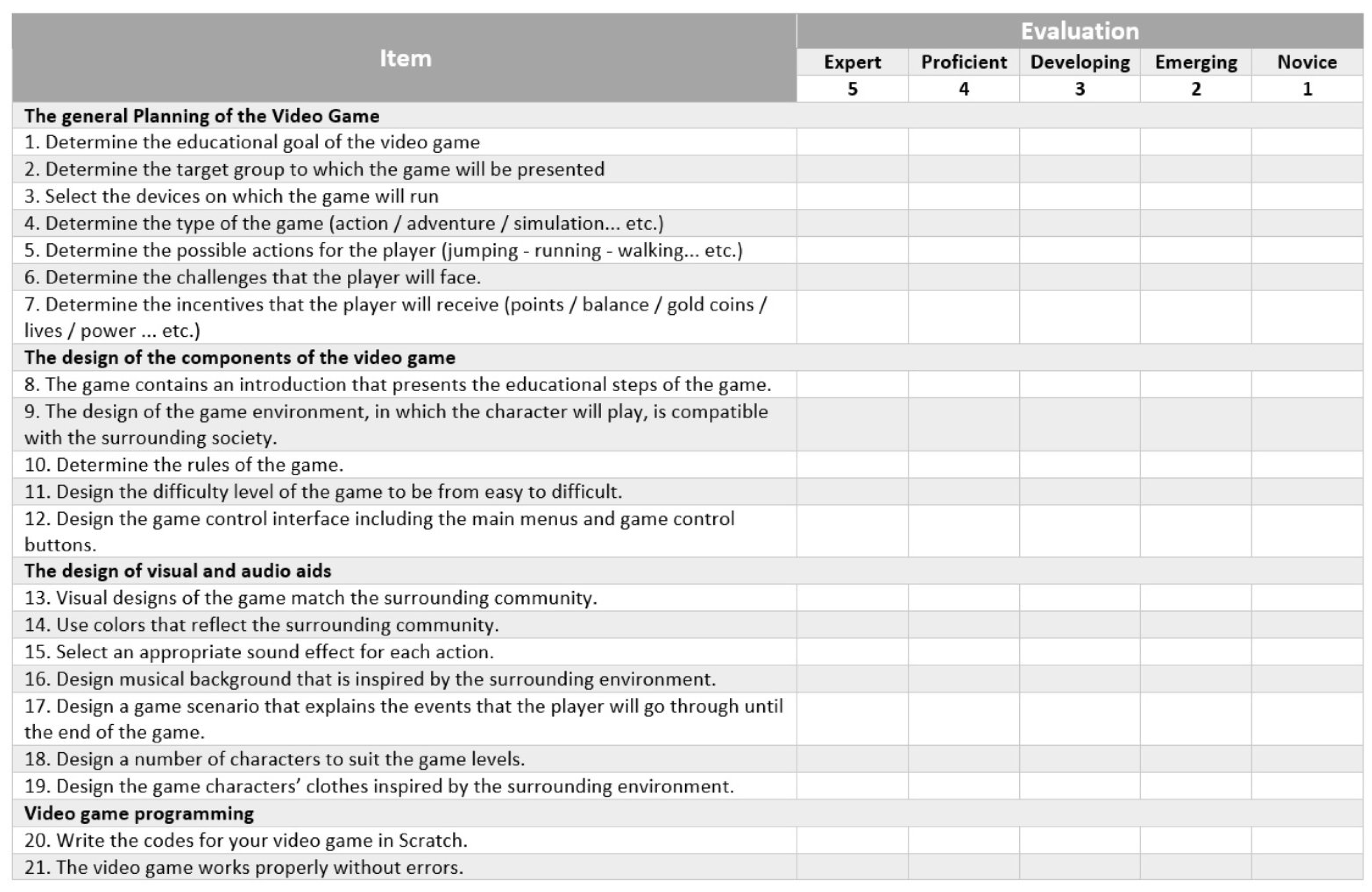
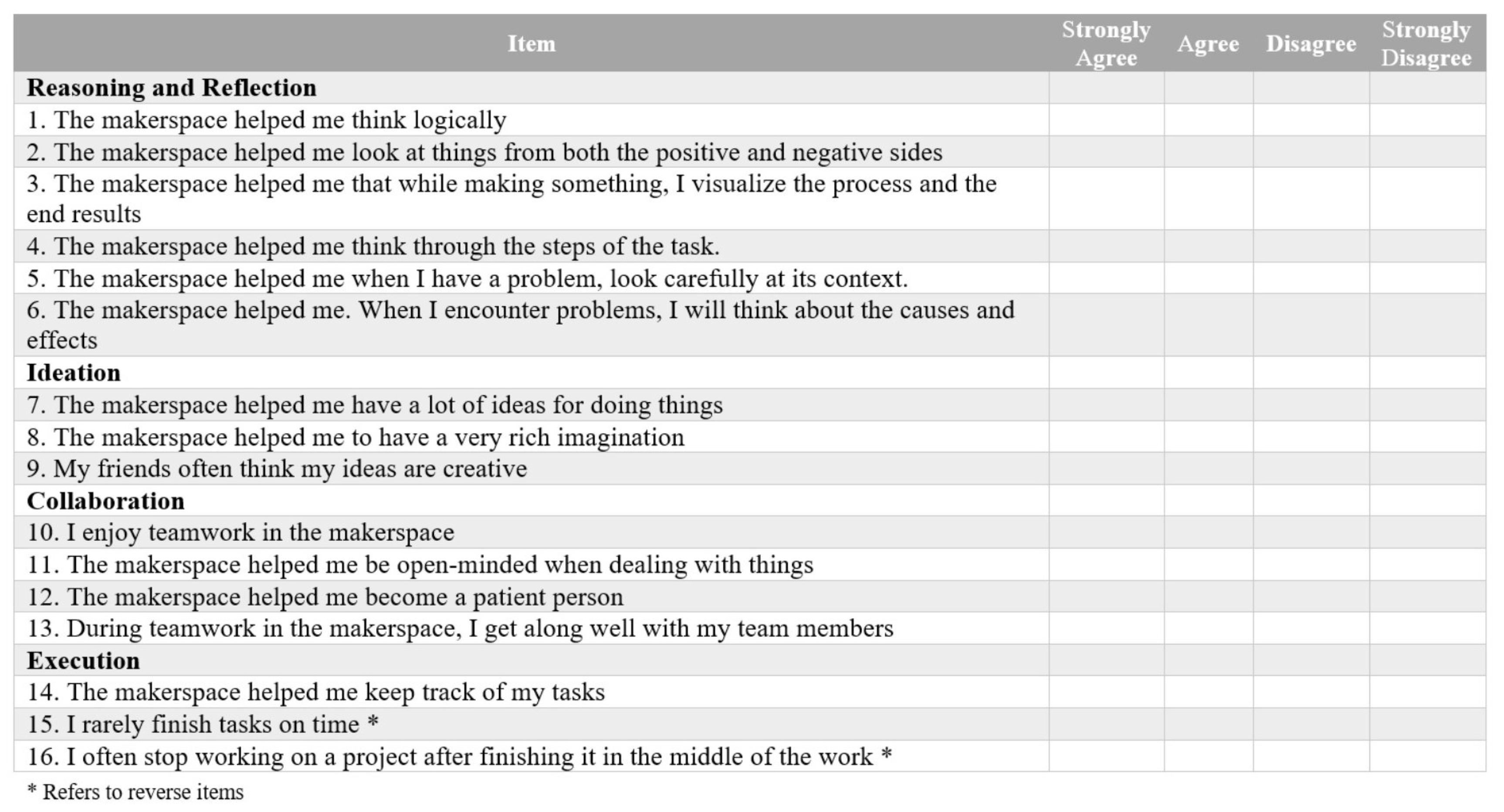
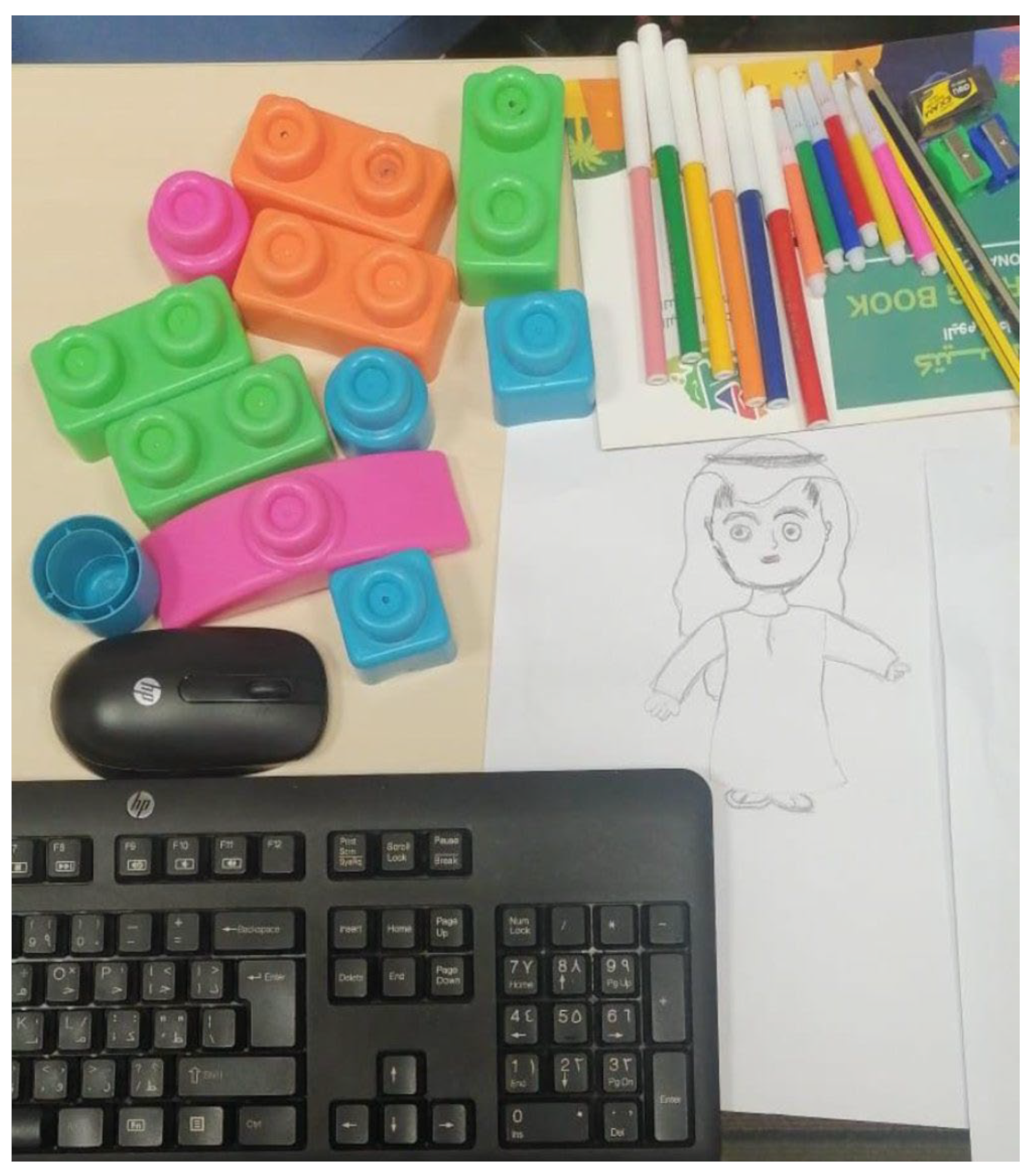
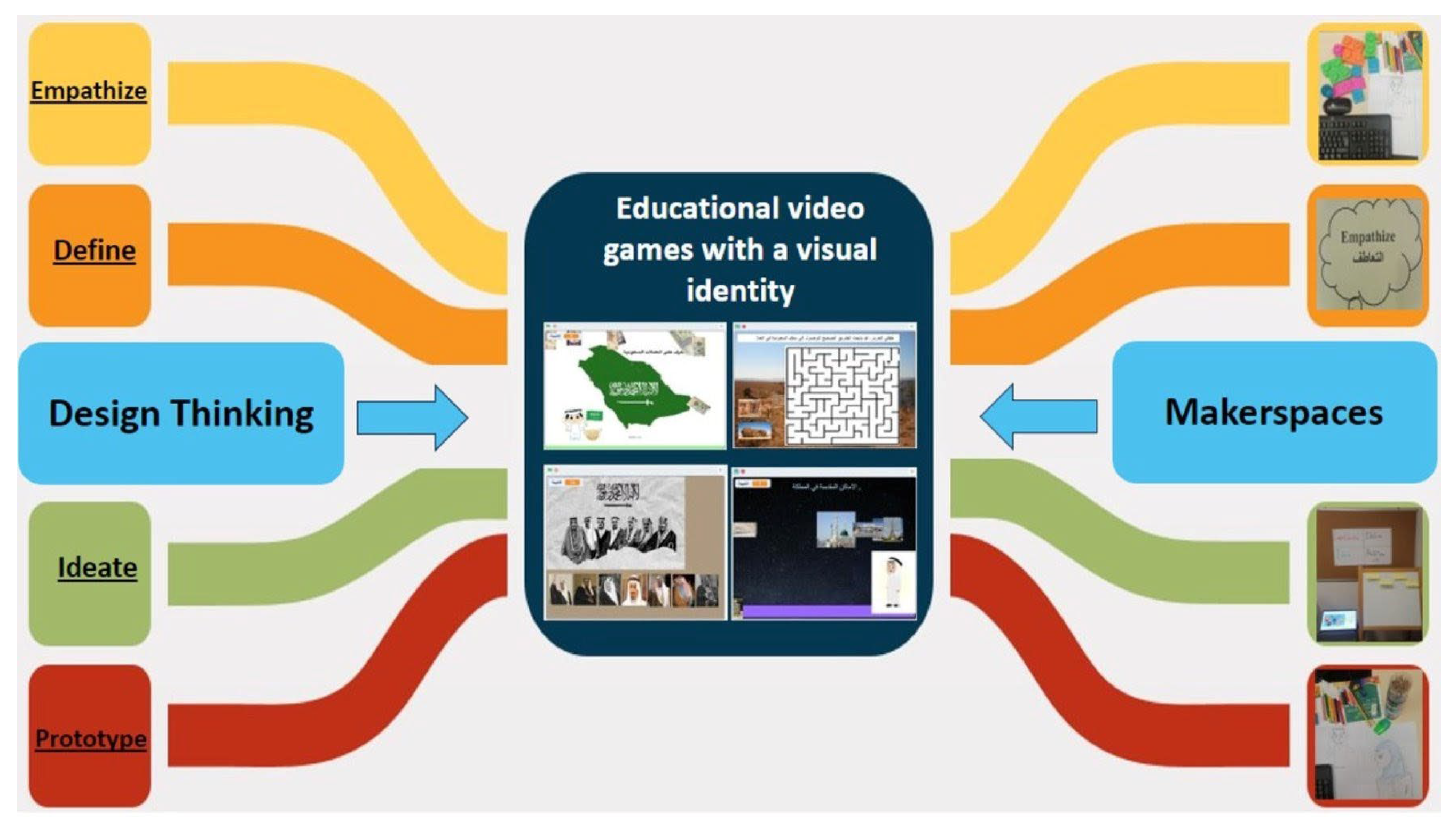




| Group | N | Mean | S.D. | t | df | Sig |
|---|---|---|---|---|---|---|
| Control | 38 | 9.47 | 3.02 | 0.074 | 74 | 0.942 |
| Experimental | 38 | 9.42 | 3.21 |
| Group | N | Mean | S.D. | t | df | Sig |
|---|---|---|---|---|---|---|
| Control | 38 | 35.00 | 10.91 | 17.61 | 74 | 0.000 |
| Experimental | 38 | 69.47 | 5.17 |
| Group | N | Mean | S.D. | t | df | Sig |
|---|---|---|---|---|---|---|
| Control | 38 | 12.21 | 4.59 | 34.55 | 74 | 0.00 |
| Experimental | 38 | 51.11 | 5.21 |
Disclaimer/Publisher’s Note: The statements, opinions and data contained in all publications are solely those of the individual author(s) and contributor(s) and not of MDPI and/or the editor(s). MDPI and/or the editor(s) disclaim responsibility for any injury to people or property resulting from any ideas, methods, instructions or products referred to in the content. |
© 2024 by the authors. Licensee MDPI, Basel, Switzerland. This article is an open access article distributed under the terms and conditions of the Creative Commons Attribution (CC BY) license (https://creativecommons.org/licenses/by/4.0/).
Share and Cite
Zaky, Y.A.M.; Al Mulhim, E.N. Teacher Education: Design Thinking Approach in Makerspaces to Produce Quality Educational Video Games with a Visual Identity and Improve Design Thinking Skills. Educ. Sci. 2024, 14, 718. https://doi.org/10.3390/educsci14070718
Zaky YAM, Al Mulhim EN. Teacher Education: Design Thinking Approach in Makerspaces to Produce Quality Educational Video Games with a Visual Identity and Improve Design Thinking Skills. Education Sciences. 2024; 14(7):718. https://doi.org/10.3390/educsci14070718
Chicago/Turabian StyleZaky, Yara Ahmed Mohebeldin, and Ensaf Nasser Al Mulhim. 2024. "Teacher Education: Design Thinking Approach in Makerspaces to Produce Quality Educational Video Games with a Visual Identity and Improve Design Thinking Skills" Education Sciences 14, no. 7: 718. https://doi.org/10.3390/educsci14070718
APA StyleZaky, Y. A. M., & Al Mulhim, E. N. (2024). Teacher Education: Design Thinking Approach in Makerspaces to Produce Quality Educational Video Games with a Visual Identity and Improve Design Thinking Skills. Education Sciences, 14(7), 718. https://doi.org/10.3390/educsci14070718





